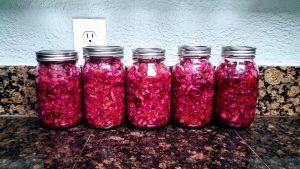
Share this post!
Whether you’re pursuing a holistic nutrition education at NTI or another institution, have children in school, are homeschooling, unschooling, or simply always open to learning, this time of year conjures feelings of new beginnings and getting back to business as long summer days have come to a close. In this blog, I share my journey of how NTI is helping me shift careers.
For me, this means my daughter is back to learning full-time at the local elementary school and I have started my final course to achieve my Nutrition Therapist Master Certification at NTI, a leader in holistic nutrition training.
To continue with the back-to-school theme, this week’s blog introduces my background, how I found Nutrition Therapy Institute, and how the school (and myself) have evolved over the past few years.
A Little Bit About Myself
As I mentioned in my previous blog about corn, I am from the Midwest. I graduated from Grinnell College in Iowa with a degree in Chemistry in 2006, then moved to Austin, Texas shortly thereafter.
From 2007 to 2017, I worked in a small environmental laboratory as an analytical chemist where I tested soils and waters for contaminants like metals, hydrocarbons, pesticides, and organics. My daily duties included operating powerful analytical equipment using techniques including gas chromatography with mass spectroscopy (GCMS) and inductively coupled plasma mass spectroscopy (ICPMS). For the last few years of my tenure there, I was the laboratory manager in addition to my analytical duties and oversaw our team of analysts to ensure the tests were done accurately and on time.
During that time, my husband and I welcomed our daughter into our lives. I was busy, both at home and at work, and my days often didn’t end until 10pm. My husband was working evenings and weekends as a successful realtor in the busy Austin market, so time together was hard to come by. I needed a change – for my family and my sanity.
As I took the scary leap into unemployment, I began to focus on things that I value in my life: cooking meals for my family, planting a garden, exercising, helping out with my husband’s business, reading, playing music, and more. I found inspiration in books and podcasts about health and wellness, realizing that I could use my background in science toward learning about holistic nutrition and how it impacts health.
I thought, if only there was a way to learn about holistic nutrition without a full-time commitment or needing to take out a loan to cover the costs?
Discovering the Nutrition Therapy Institute
The answer to my question presented itself within the pages of the quarterly magazine offered by my alma mater. In the December 2017 issue of the Grinnell Magazine, I came across an inspiring story of finding healing through holistic nutrition.
In the article, I learned about Jo Schaalman, a biology major who was on track to become a doctor. Her plans derailed when she was hit by a truck going 70 mph while riding her bicycle. Though she recovered from the accident, chronic pain, countless medications, weight gain, and depression lingered.
After seeing numerous doctors and not getting the results she was after, she took matters into her own hands by modifying her diet. As her plan began to work, she went a step further, seeking the best holistic nutrition schools by attending the Nutrition Therapy Institute. Armed with knowledge and a passion to help herself and others, she and a friend founded the company Conscious Cleanse which she continues to run out of Boulder, Colorado.
Not only was I inspired by the power of holistic nutrition to heal chronic pain, I now had an idea of where to seek an education to keep my brain active as a newly minted stay-at-home mom. I enrolled in one of my first holistic nutrition courses at NTI in the fall of 2018.
Evolution of NTI
Not having a career goal in mind and plenty of other responsibilities in life, I gladly selected the part-time track, taking only one course at a time, which amounts to only a few hours of commitment per week. In total, the holistic nutrition program will take a little less than 3.5 years for me to complete. During this time, NTI has made quite a few changes.
- Dianne and Chris Koehler assumed ownership of Nutrition Therapy Institute in July of 2019.
- NTI realigned its program offerings, replacing the separate certification levels – the CNTP and MNT – with one program, the Nutrition Therapist Master Certification (NTMC), which streamlines course requirements and allows for all graduates to pursue board certification with the National Association of Nutrition Professionals (NANP).
- Group start online courses (my preferred course experience) began to offer weekly webinars to more closely mimic the classroom experience.
- NTI moved from Denver to Olde Town Arvada, putting the Nutrition Therapist Master and Natural Food Chef programs under one roof in Nourish House.
Though I live in Texas and haven’t yet had the opportunity to visit Nourish House, I’m grateful to be a part of the NTI community and take advantage of the exciting new opportunities offered by the school. In addition, it’s been a privilege to contribute to NTI’s educational content as a blog writer for the past year.

Honing My Skills as a Writer
Math and science were always the subjects I excelled at, but during my first few courses at NTI I began to realize how much I was enjoying the process of writing out thoughtful answers to the exam questions. I never considered myself as a “writer”, but a few signs in my life have pointed me in that direction.
One particular sign was a job posting for a blog writer I noticed on NTI’s community Facebook page. Despite the fact that I didn’t have any professional writing experience (though I revised many SOPs over the years in my laboratory career), I knew this was an opportunity I couldn’t pass up. I wrote a mock blog and applied for the job.
Thanks to my initiative, I gratefully accepted the opportunity to contribute to a monthly blog based on “Nutrients You Should Know”. My first blog was about choline, and over the past year I’ve covered many nutrients and other topics of interest to me, including breathing, exercise, and the nutrients responsible for the colors of the rainbow.
This week, I began my final project, which I’m pretty stoked about. Stay tuned!
My Favorite Recipe
Recently a friend asked me what my favorite recipe to cook was. I admit, I kind of blanked. I’m not the type of cook that follows a recipe very often and haven’t taken any Natural Food Chef courses from NTI. Furthermore, it would be difficult for me to choose a favorite meal out of the many foods I enjoy.
Though many of my meals are made with simple and basic ingredients, I love to add a little interest with pickles or sauerkraut. I’ve even been known to smuggle in a jar of my homemade kraut into a diner to top off my eggs benedict with a little burst of color and flavor.
In my opinion, the little extras like pickles, a great dressing or sauce, and sauerkraut turn simple meals into something special. So, to close, I’ll include my favorite sauerkraut recipe.

Karyn’s Kraut
Ingredients:
- You can use purple or green cabbage (I like a mixture of both because it turns pink!) chopped or shredded to your desired consistency.
- Sea salt or pickling salt works best. Avoid iodized salt because the iodine might hinder the fermentation process. You’ll need about 2 tsp per pound of veggies. Use a little extra if you’re fermenting in a warm space (>70°F).
- I like to include grated carrots and daikon, quartered radishes, garlic, celery, and serrano peppers for a little kick.
Directions:
In a large crock or bowl, layer about ⅓ of your cabbage and sprinkle it with salt. Smash the cabbage with a meat tenderizer, the end of a wooden spoon, or your fist. Top with a layer of additional veggies and salt. Repeat until all ingredients are smashed and mixed.
Place a weight over the mixture. When I make a large batch, I use a gallon sized glass jar filled with water. For smaller batches, I have a ceramic weight that fits in a mason jar. Cover your setup with a towel or a loosely fitted lid (leave an inch or two of space for expansion) and leave in a cool dry place to ferment.
Over the first 24 hours, the cabbage should release enough water to fully submerge the vegetables in brine (salty water). If not, add a little water to fully cover them.
Leave the kraut until it softens and bubbles. This should take 3-5 days, or up to two weeks depending on the temperature of your environment.
Once your kraut is fermented to your liking, transfer to mason jars and store in the refrigerator for up to 6 months.
Enjoy on scrambled eggs, sandwiches, salads, or any savory meal.
Related reading…
10 Things You May Not Know About NTI
Career Opportunities In Corporate Wellness
Top 5 Reasons to Choose a Career in Nutrition Therapy
Why Nutrition Therapy Institute Stands Out in Holistic Nutrition Education
About the author: Karyn Lane is working towards her holistic nutrition certification in NTI’s Nutrition Therapist Master Program. She finds her chemistry degree a useful tool in her study of holistic nutrition and loves to treat herself as a laboratory for new recipes and cooking techniques. You can follow her on Instagram @feel.alive.nourishment.
About Nutrition Therapy Institute’s Holistic Nutrition Certification
Offering comprehensive holistic nutrition courses online and in-person to help students achieve thriving careers as holistic nutrition therapists in the field of holistic nutrition counseling and wellness. Start earning your holistic nutrition certification— attend an informational webinar to hear from our director and learn more.
Images: Image by Element5 Digital is free for use by Unsplash; Image by StockSnap from Pixabay; Kraut Image by Karyn Lane
Share this post!




















